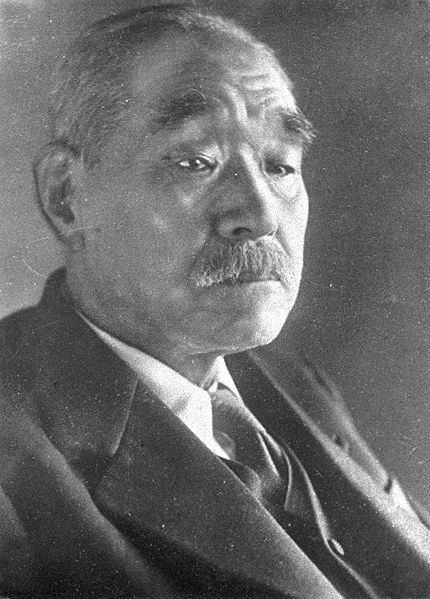<Back to Index>
- Mathematician Ivan Georgievich Petrovsky, 1901
- Composer César Antonovich Cui, 1835
- Prime Minister of Japan Kantarō Suzuki, 1868
PAGE SPONSOR


Baron Kantarō Suzuki (鈴木 貫太郎 Suzuki Kantarō, 18 January 1868 - 17 April 1948) was an admiral in the Imperial Japanese Navy, member and final leader of the Taisei Yokusankai and 42nd Prime Minister of Japan from 7 April - 17 August 1945.
Suzuki was born in Kuze village, Izumi Province (modern Sakai, Osaka Prefecture) to a samurai magistrate of the Sekiyado Domain. He grew up in the city of Noda, Kazusa Province (present day Chiba Prefecture).
Suzuki entered the 14th class of the Imperial Japanese Naval Academy in 1884, graduating 13th of 45 cadets in 1888. Suzuki served on the corvettes Tsukuba, Tenryu and the cruiser Takachiho as a midshipman. On being commissioned as ensign, he served on the corvette Amagi, corvette Takao, corvette Jingei, ironclad Kongō, and gunboat Maya. After his promotion to lieutenant in 1892, he served as chief navigator on the corvettes Kaimon, Hiei, and Kongō.
Suzuki served in the First Sino - Japanese War, commanding a torpedo boat and participated in a night torpedo assault in the Battle of Weihaiwei. Afterwards, he was assigned to a number of staff positions including that of naval attaché to Germany from 1901 - 1903. On his return, he was promoted to commander and made executive officer of the Kasuga.
During the Russo - Japanese War, Suzuki commanded Destroyer Division 2 (DesDiv 2) in 1904, and the 4th Destroyer Division in 1905, which picked up survivors of the Port Arthur Blockade Squadron during the Battle of Port Arthur. He was appointed executive officer of the cruiser Kasuga on 26 February 1904, aboard which he participated in the pivotal naval Battle of Tsushima.
After the war, he commanded the destroyer Akashi (1908), followed by the cruiser Soya (1909), the battleship Shikishima (1911) and the cruiser Tsukuba (1912). Promoted to rear admiral on 23 May 1913 he was assigned to command the Maizuru Naval District. Suzuki became Vice Minister of the Navy from 1914 - 1917, during World War I.
Promoted to vice admiral on 1 June 1917, he brought the cruisers Asama and Iwate to San Francisco in early 1918 with 1,000 cadets, and was received by U.S. Navy Rear Admiral William Fullam. The Japanese cruisers then proceeded to South America.
After stints as Commandant of the Imperial Japanese Naval Academy, Commander of the IJN 2nd Fleet, then the IJN 3rd Fleet, then Kure Naval District, he became a full admiral on 3 August 1923. Suzuki became Commander in Chief of Combined Fleet in 1924.
After serving as Chief of Imperial Japanese Navy General Staff from 15 April 1925 to 22 January 1929, he retired and accepted the position as Privy Councillor and Grand Chamberlain from 1929 - 1936.
Suzuki narrowly escaped assassination in the February 26 Incident in 1936; the would-be assassin's bullet remained inside Suzuki for the rest of his life, and was only revealed upon his cremation. Suzuki was opposed to Japan's war with the United States, before and throughout World War II. On 7 April 1945, following the Battle of Okinawa, Prime Minister Kuniaki Koiso resigned and Suzuki was appointed to take his place at the age of seventy - seven. Prime
Minister Suzuki contributed to the final peace negotiations with the
Allied Powers in World War II. He was involved in calling two
unprecedented imperial conferences which helped resolve the split
within the Japanese Imperial Cabinet over the Potsdam Declaration. He outlined the terms to Emperor Hirohito who had already agreed to accept unconditional surrender.
This went strongly against the military faction of the cabinet, who
desired to continue the war in hopes of negotiating a more favorable
peace agreement. Part of this faction attempted to assassinate Suzuki
twice in the Kyūjō Incident on the morning of 15 August 1945. After the surrender became public, Suzuki resigned and Prince Higashikuni became next prime minister. Suzuki was the Chairman of the Privy Council from 7 August 1944 - 7 June 1945. Suzuki
died of natural causes. His grave is in his home town of Noda, Chiba.
One of his two sons became director of Japan's immigration service,
while the other was a successful lawyer.